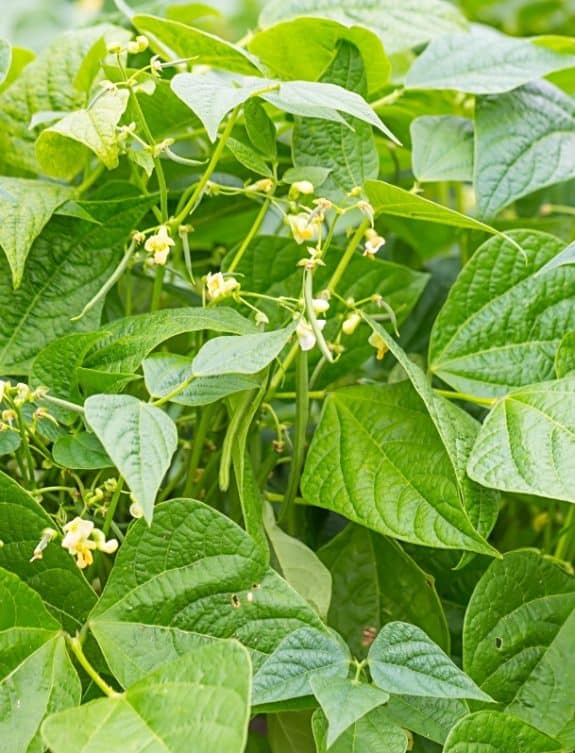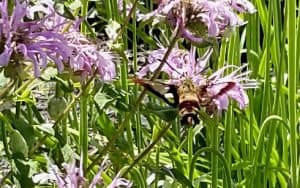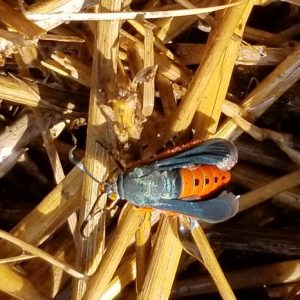
By Jennifer Fairfield, owner Garden Mill
My gardens have been absolutely teeming with all kinds of beautiful creatures lately. I have seen so many different varieties of dragonflies, bees, butterflies, moths, and caterpillars on a daily basis – not to mention the many frogs and toads hopping around.

It’s just so much fun to realize how many critters call my gardens home, and learning who they all are is even more fun. To name a few, just in the last few weeks – monarch butterfly and caterpillars (21 cats and counting), spicebush swallowtail butterfly, eastern tiger swallowtail butterfly, black swallowtail butterfly, pearl crescent butterfly, silver spotted skipper butterfly, hummingbird sphinx moth (pictured), two-spotted bumblebee, yellow bumblebee, orange-tipped wood digger bee, carpenter bee, and two-spotted longhorn bee, plus northern leopard frogs, eastern gray tree frogs, and eastern American toads.
Of course, I also have tons of birds (that’s what I get for having multiple feeders, houses, and bird baths). I won’t go into the very long list of birds in my yard – trust me when I say I have a lot. I’m sure I’ve forgotten some of the many creatures I’ve seen – and there are plenty that I’ve seen and not been able to properly identify, and lots that I’ve certainly missed altogether – but you get the idea. I am so lucky to share my home with all these beauties.

August is a time for lots of gardening tasks, not the least of which is keeping things watered (and harvested).
Most plants need about an inch of water per week, in general, but with the temperatures as high as they have been, plants have needed more, especially in soil that drains well. Clay soil tends to hold onto the moisture better, and mulch helps even more, but if we don’t get the promised rain (I’m willing to be proven wrong), pay close attention to your plants to make sure they are getting the water they need.
If you planted new trees or shrubs earlier this year, or even any time last year, you really need to be keeping up with watering them. It takes a few years for tree roots to get really established. Until then, they are not as efficient at getting water from the soil, especially dry soil. Making sure that there is sufficient water is key to making sure your new trees and shrubs survive the high heat and lack of rain.
With how dry it’s been, you might even consider giving older trees a drink. A deep, slow watering is better than a brief, shallow one, so that the water can really soak into the soil and reach the roots. The problem with trees not getting enough water is that the effects can sometimes take years to really show, especially in established trees.
You may think your trees look fine now, but next year, and the following year, you may see signs that they were stressed by the lack of water. This article from Fine Gardening gives a good explanation of how drought affects trees and shrubs.

Container plants need to be watered even more frequently than the ones planted in the ground. If they are under the cover of a porch or building overhang, they aren’t as likely to get the benefit of any rain we do happen to get. On the other hand, if they are out in the open, the sun is baking them.
Remember to give container plants a little food regularly too, to keep them looking good throughout the remainder of the season.
Keep deadheading the annual flowers in your container plantings as well as bedding plants to ensure continuous blooms. Perennials that bloom at this time of year should also generally be deadheaded regularly.
There are lots of good reasons to deadhead perennials – it can help produce a second flush of blooms, gives the plant a chance to put down more roots before cold weather, and can help to control seeding of new plants in places you may not want them.
Harvesting is the major activity of vegetable gardening in August. I am awash in zucchini and beans right now, and have harvested about half of my garlic (the rest will be ready in the next couple of weeks). My cherry tomatoes are just now starting to ripen, and cucumbers are just getting started (I was late getting them in the ground this year).
If you have lots of veggies maturing now, keep up with picking them – I go out pretty much every day to check on progress in my garden. Keeping them harvested keeps the plants producing. If you let them go too long, the plants will stop putting out new fruit and work on maturing the seeds of the fruit they have.
Plant “succession” plants in your veggie garden this month, as you pull out things that are finished producing. Beets, radishes, lettuces, spinach, Swiss chard, kale, and peas all can be planted now for late summer and early fall harvest. Take a look at the seed packet for the “days to maturity” to determine how late you can plant and still harvest before frost (and some things, like kale, are even better after a light frost).
To figure out your safe planting time frame, just count backwards from your average first date of frost (usually around October 1st for our area, but you can get detailed information for your zip code here). So, if your packet says that the days to maturity is 45 and it takes 5 to 10 days to germinate, then you need to make sure that you have your seeds in by no later than today, Aug. 7.

Just because we haven’t been getting a lot of rain, don’t think that your garden is safe from disease pressure. We have been experiencing some pretty significant morning dews, which provide perfect conditions for some diseases. The Michigan State University Extension Program has reported downy mildew in cucumbers in a hoop house, and early blight in some tomatoes in the area. Prevention is easier than trying to cure a disease, once it has gotten hold, but if you are seeing signs of infection, there are some things you can do to slow down the damage.
The first thing you need to do is identify the problem. Cornell University has a really good website that can help.
Once you know what you’re dealing with, you can decide on the best option for controlling it. We have a few different products in the store that can help with both preventing and controlling a variety of diseases, so come talk to us.
My fight with various pests this year continues – from Japanese beetles and cutworms to sawfly larva in my flower gardens, and Mexican bean beetles, squash vine borers (adult moth shown here), and tomato hornworms in my veggie garden. The chipmunks seem to have moved on, now that there aren’t any seeds for them to dig up – though that may change as I start planting seeds again this weekend.
Keep an eye out for insect pests around your plants. Controlling them is important, not just because they eat your hard work, but also because they transmit infection from diseased plants they’ve visited to your otherwise healthy plants.
We carry a number of options for pest control, including some organic choices that are very effective. But be sure to read the labels on whatever you choose, as these products can generally also kill beneficial insects. The best way to minimize harming bees and other beneficials is to be very precise in your spraying – only directly spray the pest you are trying to kill, and don’t overspray.
Broadcast spraying will almost guarantee that you kill things you don’t intend to, and spraying until the leaves drip means that you will have pesticide dripping onto other plants or the ground, where beneficials can come in contact with it.
Did you know – immature fireflies are predators that eat things like slugs and snails? They live in and on the soil, helping to keep these and other unwanted pests under control. So, keeping insecticides from dripping to the ground will help these helpful creatures alive and helping out in your garden.
Another way to help keep insects under control is to invite more birds to your yard. Insects make up a large part of the diet of most birds, including hummingbirds. Providing birds with clean water for drinking and bathing is a terrific way to get them to hang around your yard. Many birds are especially attracted to moving water, so if you already have a birdbath, consider putting in a dripper or mister to catch the attention of passing birds.
Speaking of birdbaths, keep them clean. Birds are always looking for good sources of drinking and bathing water, and keeping them clean can help keep the birds healthy.
I know I said it last month, but please do remember to keep your hummingbird feeders cleaned out. This heat will speed up the growth of bacteria and fungus in these feeders, which can be dangerous to those beautiful flying jewels.




